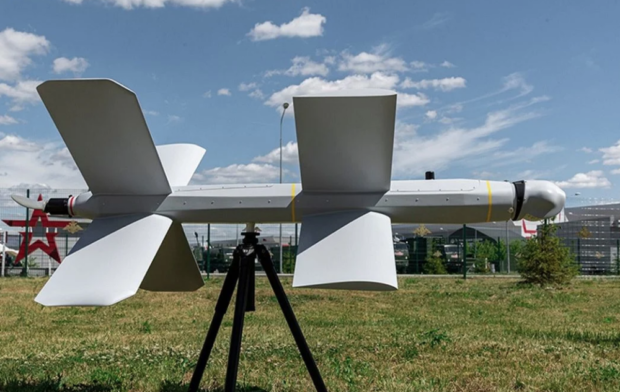Russia claims that its Lancet loitering munition (or ‘suicide,’ ‘kamikaze’ drone) has a first-of-its-kind anti-laser jamming technology that makes it immune to many anti-drone systems.
Russian loitering munitions like Lancet and KYB (or ‘Cuba’ as it has come to be popularly referred to) manufactured by the Russian company Zala have seen significant success.
Numerous videos show Lancet drones hitting Ukrainian artillery, tanks, radars, troops concentrations, lightly armored vehicles, and buildings.
Enter The Lancet-3 & KYB Suicide Drones
Manufactured by Zala and Kalashnikov, the Russian Lancet-3 is a lightweight loitering munition with a three-kilogram warhead and a 40-minute endurance. It is a further development of the KYB Kub (Cube) loitering munition, a flying-wing design that was combat tested in Syria in 2019.
The Lancet-3 has a take-off weight of 12 kilograms and is launched via a rail-mounted catapult system, capable of hitting targets up to a distance of 40 kilometers. It has two sets of X-shaped wings that can be folded and packed into a carrier trunk.
The Lancets are now reported to be present with nearly all Russian units in south and eastern Ukraine, defending against Ukrainian counterattacks and consolidating their hold in the pro-Russian regions that recently voted in a referendum to remain with Moscow.
Ukraine claimed on October 12 that it had shot down two Zala Lancet drones, besides many Iranian-origin Shahed-136 kamikaze drones.
After a high-level meeting held against the backdrop of the Russian aerial attack, General Mark Milley, chairman of the US Joint Chiefs of Staff, told reporters that the US and its allies needed to give Ukraine air defense systems so that it could defend its airspace against incoming attacks from Russian forces.
However, advanced AD systems like the German IRIS-T, Soviet-origin S-300, Buk, and Osa are inadequate in dealing with Russian loitering munitions and Iranian Shahed-136 suicide drones.
The US, too, recently reported having sent the first batch of the National Advanced Air-to-Surface Missile Systems (NASAMS). Their impact on Russian air strikes is yet to be seen.
Russia has not been relying heavily on its air force. It has maintained a significant ground operation with overwhelming gun and rocket artillery fire, long-range cruise missile strikes, and limited special operation strike behind enemy lines.
Russia Says Drones Can Resist ‘Taser Laser’
A report quoted ROSTEC, the umbrella parent company that holds all state-run Russian arms manufacturers and weapons export firms, saying that its Lancet drones are resistant to laser weapons.
“The Russian Lancet kamikaze drone cannot be harmed by the latest laser weapons due to the built-in anti-laser protection. It is almost impossible to intercept and destroy. Thanks to the built-in anti-laser protection, even the latest laser weapons against drones are not afraid of this drone [sic],” read the verbatim Google translation.
Expert Speak
Miguel Miranda, founder and editor of 21st Century Asian Arms Race said that while it was difficult to comprehend what ROSTEC meant, it can be assumed it refers to the materials in the UAV.
“Those might be resistant to high-energy beams,”
Miranda added. The popular understanding of the principle on which laser weapons are based is that they are high-energy, high-temperature beams. These are expected to ‘overheat’ (or ‘fry’) critical electronic circuits in cruise missiles, jets, or even drones.
Former IAF fighter pilot Rajiv Tyagi too indicated that the laser protection mentioned in the report could be the materials with which the drone is built.
“Laser frying will be successful only till aggressive drones begin using mirrored surfaces to reflect the lasers,”
he said. Tyagi is also a technology and software professional specializing in designing subsystems that replace old Air Defense (AD) platforms.
David Shank, an integrated air and missile defense and C-UAS consultant, said that anti-drone systems remain projectile-based, within the ‘kinetic’ category.
These traditional gun and missile systems hit or shoot down their targets.
“Non-kinetic based systems such as Radio Frequency (RF) and GPS jammers possess a credible ability to defeat specific groups of drones. But laser weapons that I am familiar with lock onto a target and burn to an extent in which the drone becomes disabled/no longer able to fly,”
Shank said. Shank, however, added that he, too, was unaware of any laser-based C-UAS system used by Ukraine.
Former IAF Jaguar pilot Vijainder K Thakur said laser and microwave frying are
“very popular,” making “laser protection a desirable feature in any drone.” “Drone electronics and communication links need to be protected,” Thakur added.
While there have not been any reports of laser-based C-UAS systems with Ukraine, Russia’s laser-resistant technology on the Lancet still makes it ‘future-proof.’ Such weapons are likely to become commonplace, considering the scale of military aid pouring into Ukraine.
Photo: Zala Lancet 3
Source: Eurasian Times

